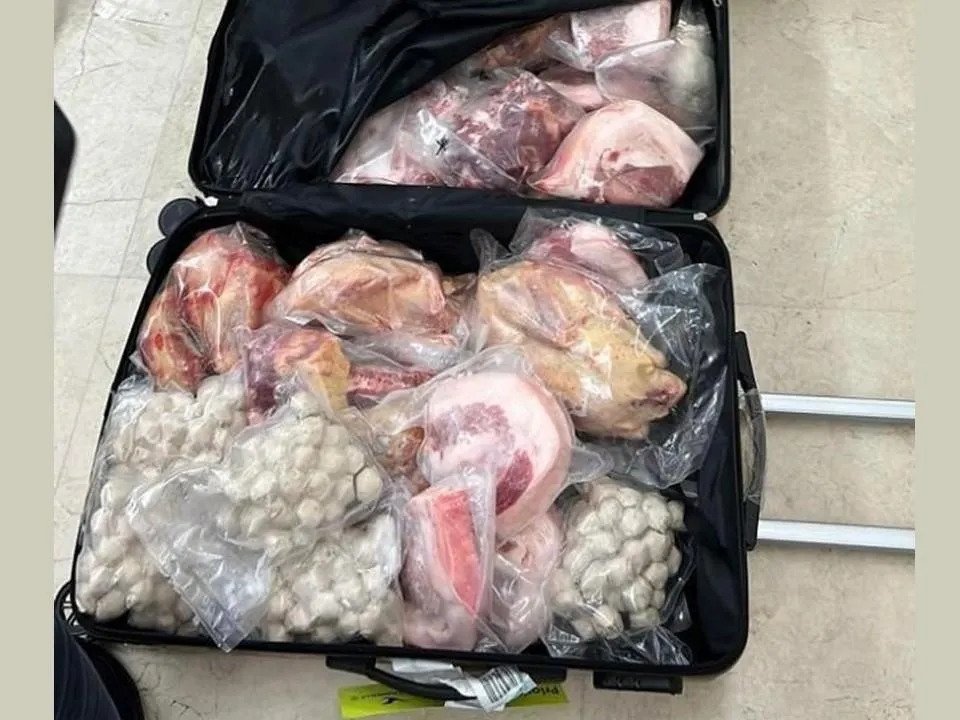网民不解男子为何从中国带226公斤冻肉挑战樟宜机场海关
深扒男子为何不惜一切带肉来新
|1 min read

<p>68岁男子从中国飞抵新加坡,拖着八个装有226公斤冷冻肉的行李箱,入境樟宜机场时被罚1万7500 新元。</p> <p>移民局人员今年6月8日,在樟宜机场检测到八个装有不同肉类的行李箱。</p> <p><img src="“https://i.imgur.com/jpnIg65.png“alt=““/"></p> <p>(新加坡食品局)</p> <p>这些行李箱都属于来自中国的旅客王连胜(音译)。约226公斤的冷冻肉类应有尽有,包括鸡肉、猪肉、牛肉、羊肉、兔子肉以及一些丸子等(差点就集全12生肖了)。</p> <p>网民看到这则新闻的第一反应都是:真是太大胆、太天真了,怎么可能在没申报的情况下,带着这么多肉类通关,</p> <p><img src="“https://i.imgur.com/AcMS34J.png“alt=““/"></p> <p>226公斤的肉,相等于1.5头成年猪的重量。</p> <p>有网民就说,光是把这些装有肉的行李运抵机场,就需要叉车来帮忙了。</p> <p><img src="“https://i.imgur.com/yMbp18t.png“alt=““/"></p> <p>另一个让网民深感疑惑的问题是:男子非法进口这些肉,是来卖还是自己吃呢,</p> <p>有网民猜测,如果男子是准备拿来卖的,可能是经营麻辣香锅店或火锅店,才需要这么多种肉类。</p> <p><img src="“https://i.imgur.com/PG8gQwn.png“alt=““/"></p> <p>另一网民则说,如果是自用的,除了兔子肉,其他肉类,新加坡都有啊。难道他以为新加坡很落后,没有超市也不能买到肉吗,</p> <p><img src="“https://i.imgur.com/t6dVOnL.png“alt=““/"></p> <p>也有网民指出,新加坡不从中国进口生肉。有些上了年纪的新移民长者或许比较喜欢吃有“家乡味”的肉类,不然就是吃不惯新加坡的肉才会出此下策。</p> <p><img src="“https://i.imgur.com/6W09Z0"> <img src="“https://i.imgur.com/GfGiYbe.png“alt=““/"></p> <p>另一网民则推测说,或许担心新加坡通胀太厉害,物价太贵了,只好从老家搬来一年分的肉类。</p> <p><img src="“https://i.imgur.com/8r1ooR3.png“alt=““/"></p> <p>根据农粮局最新数据,每名新加坡人在2021年平均吃了62公斤肉。</p> <p>他带的分量,足够一家人吃上一年了,</p> <p>也有网民猜想,或许他要开烤肉派对,请很多亲友来吃。其实,新移民挺爱分享家乡美食,他们返新时都会带上家乡特产,回来送给朋友,与本地人一起分享。</p> <p><img src="“https://i.imgur.com/gdMZn02.png“alt=““/"></p> <p><img src="“https://i.imgur.com/K0aWnJs.png“alt=““/"></p> <p>不过,从中国最靠近新加坡的省份海南岛飞来新加坡都要3个半小时,这还没加上候机和抵达办理手续等时间,生肉长时间处于“退冰状态”,难道不担心吃了肚子痛甚至是食物中毒吗,而且从照片所看,这些冷冻肉类早已开始退冰。</p> <p>网民提议说,无论是自用还是“非法进口”,包装的时候也应该用保冷袋啊。</p> <p><img src="“https://i.imgur.com/ZSbT8lb.png“alt=““/"></p> <p>有网民也开始担心自己旅行时,会否碰到这类爱携带冰冻物品却没有妥善包装好的乘客,导致解冻后流出来的“汁水”污染到自己在飞机托运舱内的行李。</p> <p>红蚂蚁温馨提醒:买行李箱还是选购防水的材质吧。</p> <p><img src="“https://i.imgur.com/r0aCAJn.png“alt=““/"></p> <p>其实,新加坡是不允许从中国直接携带新鲜肉类入境的。</p> <p>新加坡食品局允许旅客从一些获批准的国家携带最多5公斤的肉品入境。</p> <p>不过,无论是牛肉、羊肉、猪肉还是鸡肉,中国都不在批准名单中。</p> <p>可携带肉品入境的批准名单如下:</p> <p><img src="“https://i.imgur.com/KnLcLH1.png“alt=““/"></p> <p>(新加坡食品局)</p> <p>食品局指出,所有进口食品都必须符合当局的规定,并由合法进口商进口,每样食品都须申报并获得入口准证。</p> <p>非法进口肉类和海鲜产品的违例者,一旦罪成将被罚款最高5万元,或监禁长达两年,或两者兼施;再次被定罪者,可被罚款不超过10万元,或监禁最长三年,或两者兼施。</p> <p>回到这位携带生肉入境的男子,移民局随后通知食品局,这批肉类已被销毁。至于王连胜,因为罪成而被罚款1万7500 元。</p> <p>本地的牛肉每公斤价格最近在28 新元左右。有网民于是调侃说,这名男子支付了每公斤近80 新元的高价啊。这还不包括成本和运费。真的是偷鸡不着蚀把米,得不偿失啊,</p> <p><img src="“https://i.imgur.com/84"></p> <p>如果他是自己乘搭飞机,顺带这些肉类,那么光是行李费就很可观了。</p> <p>一般航空的经济舱每人可免费托运2件行李,重量不能超过30公斤,如果乘搭廉价航空,能托运的重量就更少了。</p> <p>除非是乘搭头等舱,再加上你是飞行常客,最多可托运4个行李共100公斤。</p> <p>也就是说,王连胜需要购买4到9个额外托运行李的份额,才能把他的冰冻肉运来。</p> <p>红蚂蚁查看了一下中国南方航空对额外行李的收费,需要4378人民币(883 新元)至9460人民币(1900 新元)。</p> <p><img src="“https://i.imgur.com/PowLdit.png“alt=““/"></p> <p>(中国南方航空)</p> <p>如果他是到机场才被发现行李超重,那所需支付的款项更是天价。</p> <p>如果这位男子是透过空运或者还有其他人同行把冷冻肉送抵,那价格应该会便宜些。</p> <p>网民非常困惑地问,这些肉类值得额外购买行李重量以及冒着被罚款的风险吗,除非他带的是A5和牛。</p> <p><img src="“https://i.imgur.com/Skyak1w.png“alt=““/"></p> <p>最最最让人不解的是,为何装着这些冰冻生肉的行李可以上飞机呢,起航机场难道没有对托运行李进行检查,</p> <p><img src="“https://i.imgur.com/vFlqZ2I.png“alt=““/"></p> <p>一些网民也很好奇,这个小哥是否是第一次“走私”肉。</p> <p><img src="“https://i.imgur.com/9dUHO3d.png“alt=““/"></p> <p>也许大家都想多了,“肉男”只是想证明:跟着哥有肉吃,</p>

